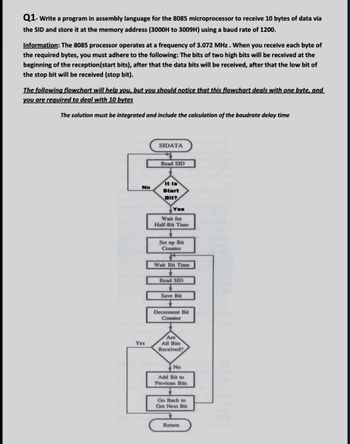
Database System Concepts
7th Edition
ISBN: 9780078022159
Author: Abraham Silberschatz Professor, Henry F. Korth, S. Sudarshan
Publisher: McGraw-Hill Education
expand_more
expand_more
format_list_bulleted
Concept explainers
Question

Transcribed Image Text:Q1- Write a program in assembly language for the 8085 microprocessor to receive 10 bytes of data via
the SID and store it at the memory address (3000H to 3009H) using a baud rate of 1200.
Information: The 8085 processor operates at a frequency of 3.072 MHz. When you receive each byte of
the required bytes, you must adhere to the following: The bits of two high bits will be received at the
beginning of the reception (start bits), after that the data bits will be received, after that the low bit of
the stop bit will be received (stop bit).
The following flowchart will help you, but you should notice that this flowchart deals with one byte, and
you are required to deal with 10 bytes
The solution must be integrated and include the calculation of the baudrate delay time
Of+CD!HID+[00
Yes
SIDATA
Read SID
Start
Bit?
Wait for
Half-Bit Time
Set up Bit
Counter
Wait Bit Time
Read SID
Save Bit
Decrement Bit
Counter
All Bits
Received?
Add Bit to
Previous Bits
Go Back to
Get Next Bit
Return
IMUNI
Expert Solution
This question has been solved!
Explore an expertly crafted, step-by-step solution for a thorough understanding of key concepts.
Step by stepSolved in 4 steps

Knowledge Booster
Learn more about
Need a deep-dive on the concept behind this application? Look no further. Learn more about this topic, computer-science and related others by exploring similar questions and additional content below.Similar questions
- Translate the following C code to MIPS assembly, assuming that the variables f, g, h, i, and j correspond to registers $50, $s1, $s2, $s3, and $54 respectively. Also, assume that the base addresses of arrays A and B are contained in $56 and $s7 respectively, and that each element of arrays A and B are 4-byte words: B[8] =A[i] + A[j]; Which of the following MIPS assembly code snippets correctly performs the above operation? sll $t1, $s3, 2; add $t1, $56, $t1; lw $12, 0($t1); sll $t1, $s4, 2; add $11, $s6, St1; lw $13, 0($t1); add $12, $12, $t3; sw $12, 32($s7) sll $t1, $s3, 2; add $11, $s6, $t1; lw $12, 0($t1); sll $t1, $s4, 2; add $11, $s6, $t1; lw $13, 0($t1); add $t4, $12, $t3; sll $15, $t0, 2; add $15, $s7, $15; sw $t4, 32($15) Iw $11,0($s3); Iw $12, 0($s4); add $13, $11, $12; sw $13, 32($s7) sll $t1, $s3, 2; lw $12, 0($t1); sll $t1, $s4, 2; lw $13, 0($t1); add $t4, $t2, $t3; sw $t4, 32($s7)arrow_forwardsim8085arrow_forwardUse the following data declarations. Assume that the offset of byte Val is 00000000: .data byte Val sbyte 1,2,3.-7h word Val word 1000h.2000h 3000h, 4000h dwordVal dword 34567890h, 90785634h, 1234674Sh Show the value of the final destination operand after each of the following code fragments has executed: (If any instructions is invalid, indicate "INV" as the answer and briefly explain why) a. moy di 2 mov al, byte Val[di] b. mov bx, word Val mov esi, offset wordVal+4 xchg bx, [esi] R c. movsx cx, byte Val+3 d. mov ax, word ptr [dwordVal mov bl. byte ptr [dwordVal +10] e. mov al, 80h number add al 40h signed ;signed number answer al-= answer bx= answer (show your answer in binary) CX- answer |esi= answer bl= SF=arrow_forward
- The first two bytes of a 4M x 16 main memory have the following Hex values: Byte 0 is FE Byte 1 is 04 If these bytes hold a 16-bit two's complement integer, what is its actual decimal value if: a) Memory is big endian? b) Memory is little endian? 2. The memory unit of a computer has 2M Words of 32 bits (or 4 bytes) each. The computer has an instruction format with 4 fields: an opcode field; an addressing mode field to specify 1 of 6 addressing modes; a register address field to specify one of 7 registers; and a memory address field. Assume an instruction is 32 bits long. Answer the following: How large must the addressing mode field be? How large must the register field be? How large must the address field be? How large is the opcode field?arrow_forward1. Convert the following C code to MIPS Assembly : int b = OXBCD1238A; int Mask = OXA0000005; int D= 0; int m3=0; void main() { m3 = b | Mask; // Bitwise OR m3 = D shifted left logical by 2 bits // D is shifted left logical by 2 bits D = m3; printf ( "The value of D is: %d “, D); }arrow_forward
arrow_back_ios
arrow_forward_ios
Recommended textbooks for you
 Database System ConceptsComputer ScienceISBN:9780078022159Author:Abraham Silberschatz Professor, Henry F. Korth, S. SudarshanPublisher:McGraw-Hill Education
Database System ConceptsComputer ScienceISBN:9780078022159Author:Abraham Silberschatz Professor, Henry F. Korth, S. SudarshanPublisher:McGraw-Hill Education Starting Out with Python (4th Edition)Computer ScienceISBN:9780134444321Author:Tony GaddisPublisher:PEARSON
Starting Out with Python (4th Edition)Computer ScienceISBN:9780134444321Author:Tony GaddisPublisher:PEARSON Digital Fundamentals (11th Edition)Computer ScienceISBN:9780132737968Author:Thomas L. FloydPublisher:PEARSON
Digital Fundamentals (11th Edition)Computer ScienceISBN:9780132737968Author:Thomas L. FloydPublisher:PEARSON C How to Program (8th Edition)Computer ScienceISBN:9780133976892Author:Paul J. Deitel, Harvey DeitelPublisher:PEARSON
C How to Program (8th Edition)Computer ScienceISBN:9780133976892Author:Paul J. Deitel, Harvey DeitelPublisher:PEARSON Database Systems: Design, Implementation, & Manag...Computer ScienceISBN:9781337627900Author:Carlos Coronel, Steven MorrisPublisher:Cengage Learning
Database Systems: Design, Implementation, & Manag...Computer ScienceISBN:9781337627900Author:Carlos Coronel, Steven MorrisPublisher:Cengage Learning Programmable Logic ControllersComputer ScienceISBN:9780073373843Author:Frank D. PetruzellaPublisher:McGraw-Hill Education
Programmable Logic ControllersComputer ScienceISBN:9780073373843Author:Frank D. PetruzellaPublisher:McGraw-Hill Education

Database System Concepts
Computer Science
ISBN:9780078022159
Author:Abraham Silberschatz Professor, Henry F. Korth, S. Sudarshan
Publisher:McGraw-Hill Education

Starting Out with Python (4th Edition)
Computer Science
ISBN:9780134444321
Author:Tony Gaddis
Publisher:PEARSON

Digital Fundamentals (11th Edition)
Computer Science
ISBN:9780132737968
Author:Thomas L. Floyd
Publisher:PEARSON

C How to Program (8th Edition)
Computer Science
ISBN:9780133976892
Author:Paul J. Deitel, Harvey Deitel
Publisher:PEARSON

Database Systems: Design, Implementation, & Manag...
Computer Science
ISBN:9781337627900
Author:Carlos Coronel, Steven Morris
Publisher:Cengage Learning

Programmable Logic Controllers
Computer Science
ISBN:9780073373843
Author:Frank D. Petruzella
Publisher:McGraw-Hill Education